Ageing and sexing details:
Any American Redstart that is mostly black in spring can be immediately
recognized as an after-second-year male.

Photo by Marcel Gahbauer,
McGill Bird Observatory, May 2005
The wing of after-second-year males shows uniform primary coverts and
greater coverts.
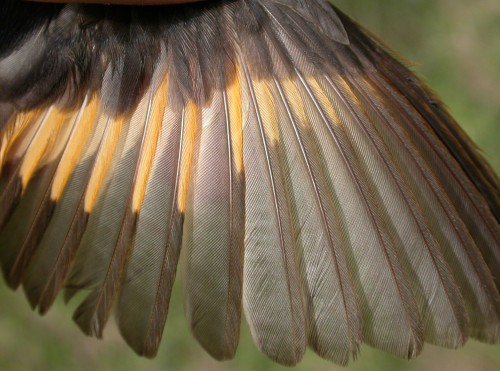
Photo by Marcel Gahbauer,
McGill Bird Observatory, May 2005
The outer rectrices (r3-r6) all have large orange patches.
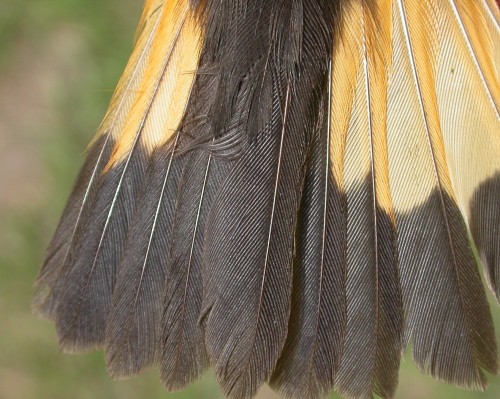
Photo by Marcel Gahbauer,
McGill Bird Observatory, May 2005
RETURN TO AGE/SEX
OVERVIEW
RETURN TO AGE/SEX
OVERVIEW
Second-year males can be easily recognized
by any black flecking on the head. Most commonly it begins in the
lores as on the bird below, but black feathers may also appear on the
throat, nape, and crown.
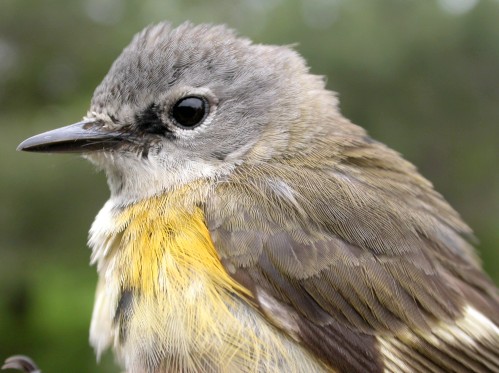
Photo by Marcel Gahbauer,
McGill Bird Observatory, May 2005
On second-year redstarts, the primary coverts are somewhat paler than
the greater coverts, and the outer primary coverts tend to be somewhat
narrow, pointed, and abraded. Note that the yellow patches on the
primaries project several mm beyond the primary coverts.
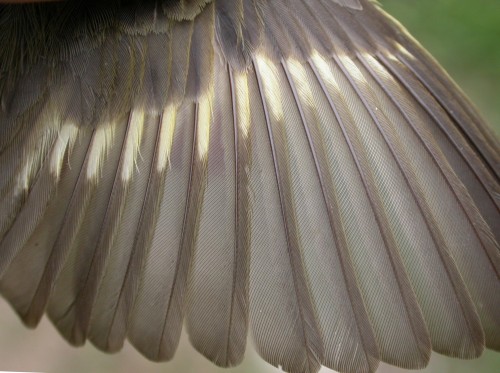
Photo by Marcel Gahbauer,
McGill Bird Observatory, May 2005
The tail of second-year males is quite similar to that of
after-second-year females.
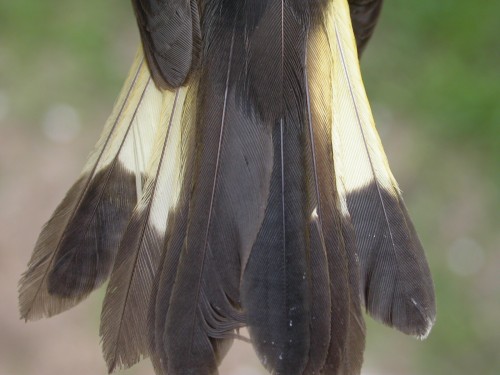
Photo by Marcel Gahbauer,
McGill Bird Observatory, May 2005
RETURN TO AGE/SEX
OVERVIEW
The pales of the redstart plumages, with no
black or orange anywhere.
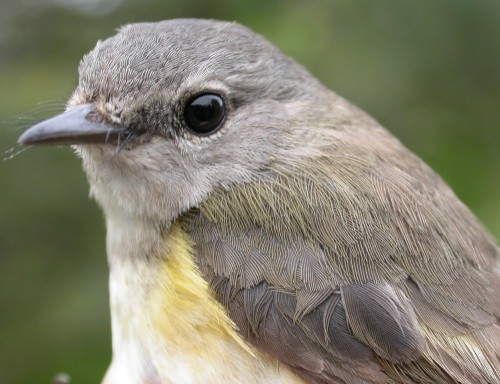
Photo by Marcel Gahbauer,
McGill Bird Observatory, May 2005
The contrast between the paler brown primary coverts and dusky brown
greater coverts is clearly visible in the photo below, as is the
complete absence of yellow marks on the primaries.
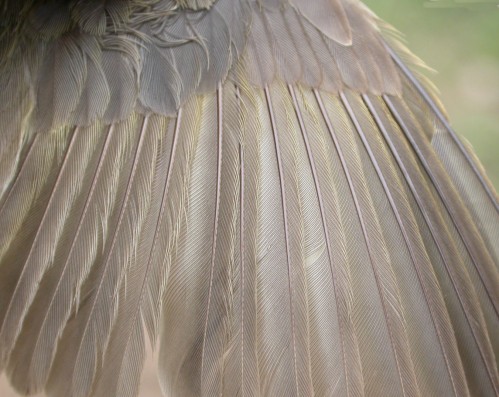
Photo by Marcel Gahbauer,
McGill Bird Observatory, May 2005
Note the very limited extent of yellow on r3 (the fourth rectrix from
the outside of the tail) that is typical of second-year females.
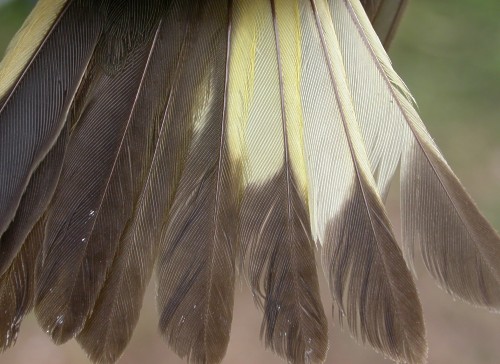
Photo by Marcel Gahbauer,
McGill Bird Observatory, May 2005
RETURN TO AGE/SEX
OVERVIEW
Any
American Redstart that is mostly black in fall can be immediately
recognized as an after-hatch-year male.

Photo by Marcel Gahbauer,
McGill Bird Observatory, August 2005
The wing of after-second-year males shows uniform primary coverts and
greater coverts, and extensive orange marks on the primaries.
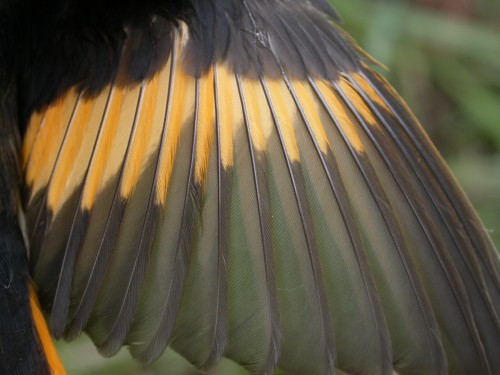
Photo by Marcel Gahbauer,
McGill Bird Observatory, September 2005
The outer rectrices (r3-r6) all have large orange patches, and there is
often also some orange on the outer side of r2.
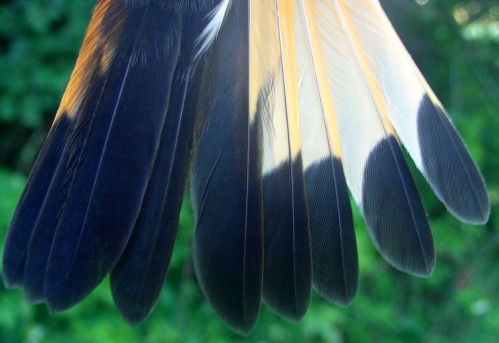
Photo by Marie-Anne Hudson,
McGill Bird Observatory, August 2007
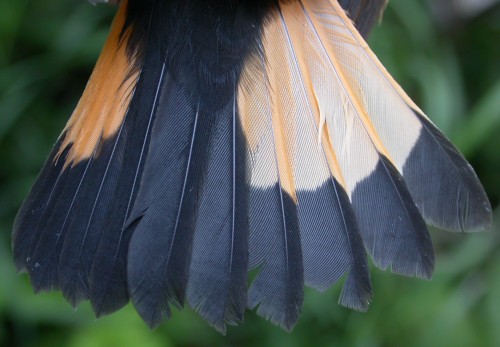
Photo by Marcel Gahbauer,
McGill Bird Observatory, August 2005
RETURN TO AGE/SEX
OVERVIEW
After-hatch-year females and hatch-year
males may have an overall similar appearance.
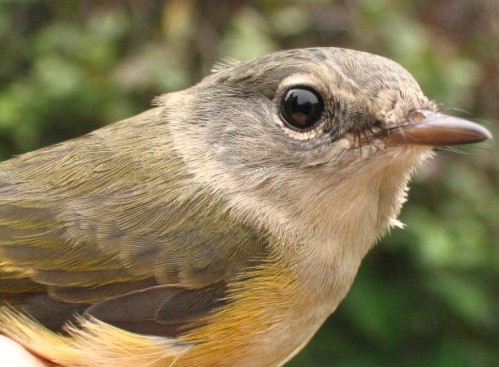
Photo by Seabrooke Leckie,
McGill Bird Observatory, September 2006
Note that the primary
coverts are similar in colour and wear to the greater coverts on
after-hatch-year females, and that the outer primary coverts are broad
and rounded at the tip.

Photo by Seabrooke Leckie,
McGill Bird Observatory, September 2006
The yellow patches on
after-hatch-year females overlap considerably in size with those of
hatch-year males and are not reliable for ageing or sexing.
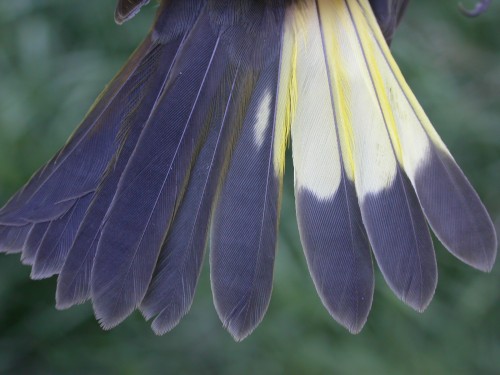
Photo by Marcel Gahbauer,
McGill Bird Observatory, August 2005
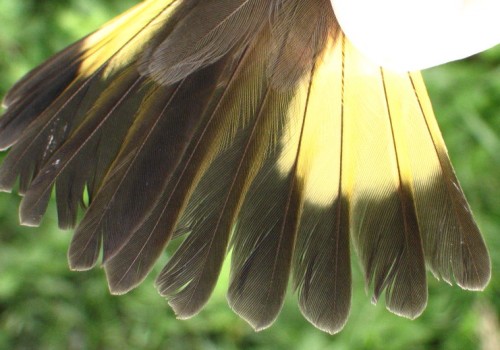
Photo by Seabrooke Leckie,
McGill Bird Observatory, September 2006
RETURN TO AGE/SEX
OVERVIEW
Hatch-year males may show some black
flecking on the face or elsewhere on the head; in the absence of this,
wing characteristics are critical to correct identification.
Though strongly orange breast side patches as in the first photo below
are suggestive of males, occasionally after-hatch-year females can be
almost as strongly marked. Note that the bird in the third (side
view) and fourth (top view) photos below shows an unusual amount of
reddish marking on the back for a hatch-year male.

Photo by Seabrooke Leckie,
McGill Bird Observatory, August 2006
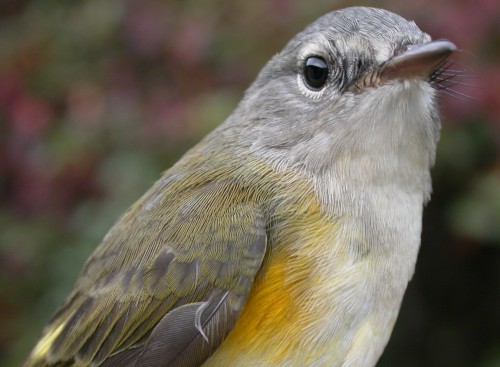
Photo by Marcel Gahbauer,
McGill Bird Observatory, August 2005
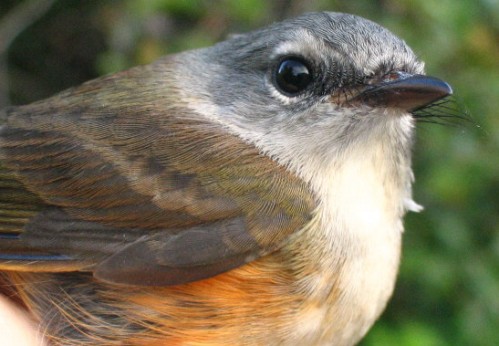
Photo by Seabrooke Leckie,
McGill Bird Observatory, August 2006
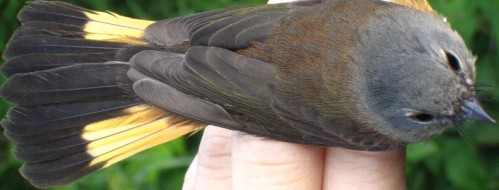
Photo by Seabrooke Leckie,
McGill Bird Observatory, August 2006
The contrast between pale brown primary coverts and
darker greater coverts can be very useful in identifying hatch-year males
and is particularly well illustrated in the first photo below. The
second photo shows that in some light this contrast does not show up as
well, but note that the relatively narrow and pointed shape of the outer
primary coverts can still be checked, and the yellow on the primaries
extending beyond the primary coverts identifies it as a male rather than
female. The second bird is also unusually pale gray on the wing.
The yellow is particularly extensive in the third example below,
highlighting the variability in this species.
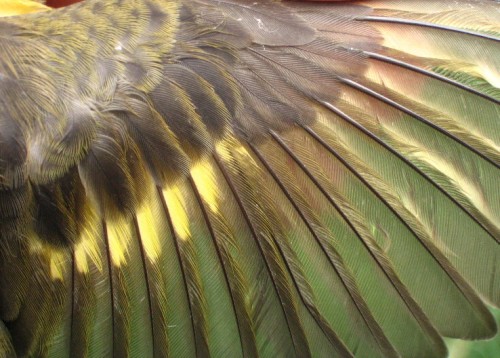
Photo by Seabrooke Leckie, McGill Bird Observatory, August 2006

Photo by Marie-Anne Hudson,
McGill Bird Observatory, August 2007

Photo by Marie-Anne Hudson, McGill Bird Observatory, August 2007
The tail of hatch-year
males is usually fairly dark, with moderately extensive yellow on r3;
the third photo below is from the abnormally pigmented individual shown
in the body photos above, and is almost like an after-hatch-year male
tail in colour.

Photo by Marie-Anne Hudson,
McGill Bird Observatory, August 2007
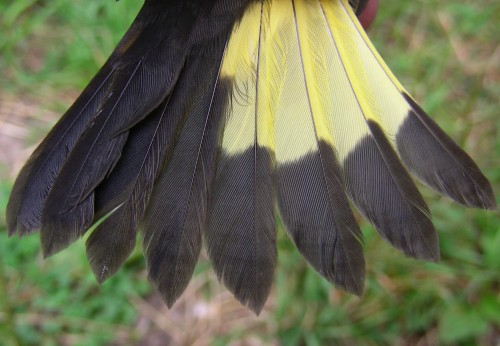
Photo by Marcel Gahbauer,
McGill Bird Observatory, August 2007

Photo by Seabrooke Leckie,
McGill Bird Observatory, August 2006
RETURN TO AGE/SEX
OVERVIEW
Hatch-year
females are by far the palest redstarts, and may be tentatively
identified just by their overall drab appearance, but wing and tail
characteristics should be consulted for confirmation.
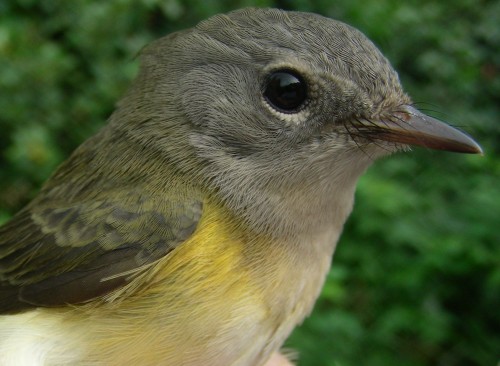
Photo by Marie-Anne Hudson,
McGill Bird Observatory, August 2007
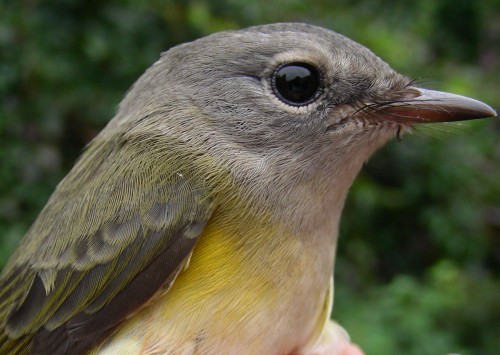
Photo by Marcel Gahbauer,
McGill Bird Observatory, August 2007
Note the absence of yellow on the primaries; and the
minimal contrast between the
primary coverts and greater coverts; sometimes there is no yellow at all
visible on the wing, as in the second photo below.
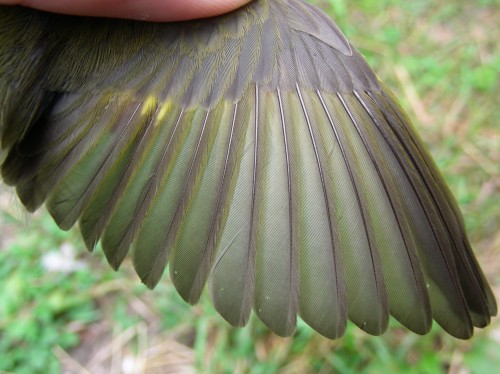
Photo by Marcel Gahbauer,
McGill Bird Observatory, August 2007
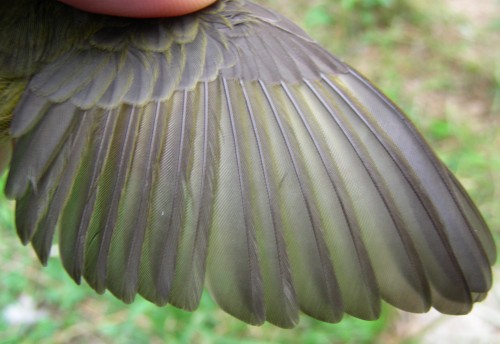
Photo by Marcel Gahbauer,
McGill Bird Observatory, August 2007
Note that on r3 there is
little yellow, and it is limited to the outer web of the feather.
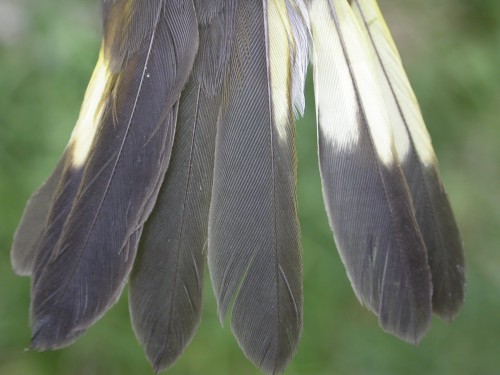
Photo by Marcel Gahbauer,
McGill Bird Observatory, August 2005
RETURN TO AGE/SEX
OVERVIEW